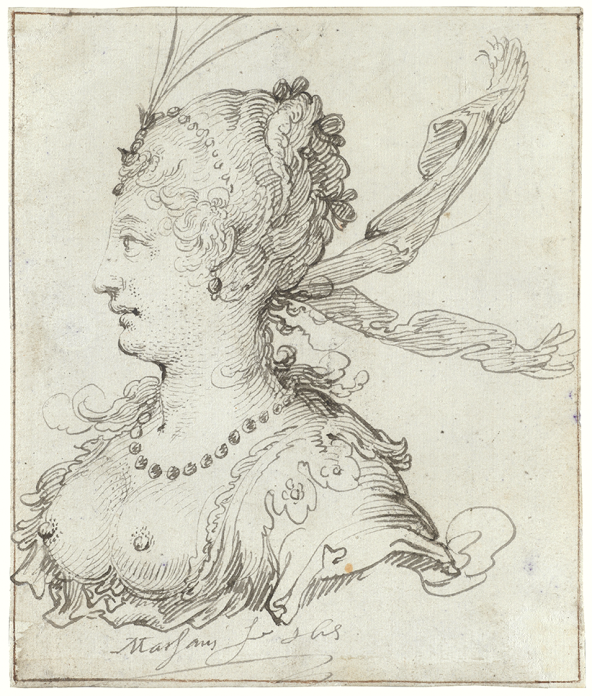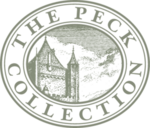Choose a background colour
Jacob Matham, Dutch, 1571-1631: Man with Plumed Hat, Depicted as Sculpted Bust, 1604
Pen in brown ink on paper; framing line in brown ink, bottom edge only.
7 11⁄16 × 5 1⁄2 in. (19.6 × 14 cm)
Recto, at lower center, signed and dated by the artist in pen, Maetham fec 1605.
- Chain Lines:
- Vertical, 25 – 27 mm
- Watermark:
- Arms of Baden Breisgau, with the letters LB (for Lörrach and Blum) ligated below. Possibly identical to that on another drawing by Matham, cf. Munich 1989 – 90, 117 (cat. 40). Similar to Laurentius & Laurentius 2007, no. 123; Tschudin, no. 400; and Briquet, no. 1075.
- Provenance:
Sale, Sotheby’s, New York, 13 January 1993, lot 2; Sheldon and Leena Peck, Boston (Lugt 3847); gift to the Ackland Art Museum, inv. no. 2017.1.51.
- Literature/Exhibitions:
None.
- Ackland Catalogue:
- 2017.1.51
This fantasy head by printmaker Jacob Matham was conceived as an independent work and shows a man in the guise of a sculpted portrait bust mounted on a stone pedestal. Although his costume and appearance evoke figures depicted in Dutch art from the previous century, his form recalls Classical marble portrait busts of famous ancient figures, which were an important source for artistic instruction.
Matham’s drawing cleverly demonstrates his ability to create a new kind of portrait bust as well as mimic different art forms simultaneously, in this instance, the cross-hatched lines and stippling of engraving and the hard, stone forms of sculpture.
Jacob Matham was the stepson of the famous Haarlem artist, Hendrick Goltzius (1558 – 1617), a printmaker of great renown across Europe who trained Matham in the art of engraving.1
Matham took over the printmaking activities of the workshop around 1600, after which Goltzius focused the rest of his career on painting. Like his stepfather, Matham was also a talented draftsman who could draw in a number of different styles with a wide range of media. While some of his drawings were his own original preparatory designs for engravings, most of them, like the present sheet, never appeared in print and must have been conceived as stand-alone works. Just under 100 drawings by Matham are known today, many of them signed and dated, and most likely made for collectors and art lovers.2
This work falls into one of the most unusual and interesting genres of Matham’s drawn oeuvre, that of the fantasy head or figure. This genre was developed by Goltzius, whose own fantasy heads likewise appear far more often in his drawings than his printed oeuvre.3
Imaginative or historicizing costume is almost always a defining feature of these works. The man’s plumed hat here, along with his hairstyle and collar, are clearly taken from the early sixteenth century. As would have been understood in Matham’s day, the foppish air of an elaborately plumed hat, found in the Renaissance prints of Lucas van Leyden and others, might represent the theme of vanity and, by extension, the brevity of life.4
Some male fantasy figures by Matham are similarly costumed in Renaissance attire.5
Others, however, wear clothing that appears entirely imaginary, likely meant to be antique or ancient in character.6
Matham treated female figures similarly.7
His drawing of a fantasy figure with exposed breasts in Dresden bears the closest stylistic comparison to the present work in terms of its scale, the use of stippling for the flesh areas, and the swift pen work for the area below Fig. 5.1.8

Jacob Matham, Bust of a Female Figure, 1605(?). Pen and ink on paper, 138 × 117 mm. Dresden, Kupferstich-Kabinett, inv. no. c 1962 – 257.
Kupferstich-Kabinett, Staatliche Kunstsammlungen Dresden, Photo: Herbert Boswank
Its date, though practically illegible, should probably also be read as 1605 based on its similarity to the Peck drawing and the matching orthography of the final digit. While certain features like a plumed hat might represent vanity, or exposed breasts an allegorical or mythological figure, clearly established subject matter was not a major concern in these works, though one does find identifying attributes on occasion.9
They are, rather, artistic exercises of the imagination. Figures are removed from the more clearly defined narrative and allegorical contexts generally demanded by paintings and prints, thereby affording the artist’s creative impulses to take freer form. Moreover, they are often suffused with a sense of individual virtuosity particular to the medium of drawing, even if some of the handling derives from Matham’s naturally ingrained graphic vocabulary of the engraver, such as crosshatching and stippling.
An added feature of this image that makes it particularly intriguing is its placement on a pedestal to give it the appearance of a bust sculpture. Replica bust sculptures of famous ancient figures (often plaster) were popular at the time with scholars and artists, as were real antique marble ones if and when collectors could acquire them. Contemporary sculptors were also commissioned to make bust portraiture of notables at the time.10
Sculpted busts could honor a historical or modern personage as well as serve as an inspirational presence for the viewer, but fantasy figures such as this were usually not treated in plastic media.
Given the particular combination of drawing a fantasy head as a bust sculpture, this image could be seen as a sophisticated witticism. For instance, the year before, Matham completed one of his largest and most interesting drawings, the Study of Three Sculpted Heads now in Munich Fig. 5.2.11

Jacob Matham, Still Life with Three Sculpted Heads, 1604. Pen in brown ink and brown wash over black chalk on paper, 351 × 463 mm. Munich, Staatliche Graphische Sammlung, inv. no. 21128.
Staatliche Graphische Sammlung München
An example of a fully developed Federkunststück, or “pen work,” it confers the visual formality of engraving to a drawing for its own sake, rather than being preparatory for a print. The presence of the tools of printmaking and drawing in the image refers to the use of such bust sculptures for the education of artists, who began their early phases of training by making drawn copies of antique plaster casts.12
The head on the right, however, seems to address the viewer with a jesting glint in his eye, and his characterization appears to be one of an actual presence, alive rather than static like the two busts beside him. One is reminded of Peter Paul Rubens’s famous warning that too much copying of antique sculpture could harden or stiffen an artist’s style, and that one should take care to apply or appropriate ancient sculpture in ways that “do not in the least smell of stone.“13
While Matham and Rubens would not meet for the first time until 1613, they were each probably exposed to these ideas about copying the antique during their respective travels in Italy.14
In the Peck drawing, too, Matham attempted to vivify his figure by portraying a living presence in the guise of a sculpture. Part of the point behind such a drawing, then, might be to instigate a dialogue about this distinction in artistic theory and practice, or to prompt a classic paragone debate about how artistic aims and outcomes can differ between sculpture and painting — or, in this case, between sculpture and drawing.
End Notes
For Matham’s biography, see the introduction by L. Widerkehr in the New Hollstein (Jacob Matham), vol. 1, xxv– lxviii.
Widerkehr 1997 (unpublished PhD dissertation) contains a catalogue of Matham’s drawings, listing seventy-three accepted works, twelve attributed to, twelve doubtful, and forty-three rejected.
For Goltzius’s fantasy heads, see Reznicek 1961, vol. 1, 204 – 05, and many of those catalogued among the “Not Identified Male Portraits” (nos. 290 – 345) and “Not Identified Female Portraits” (nos. 353 – 75). See also some of the works discussed by H. Leeflang in Amsterdam, New York & Toledo 2003, 235 – 63. For Goltzius’s influence on Matham’s own fantasy heads, see Widerkehr 1993, 242 – 44.
A well-known example is the engraving by Lucas van Leyden, A Young Man with a Skull (New Hollstein, no. 174; and Leiden 2011, no. 82), which likely served as the main inspiration for Goltzius’s famous drawing in the Morgan Library & Museum, New York, Young Man with a Skull and Tulip (Reznicek 1961, no. 332; Stampfle 1991, no. 69; Amsterdam, New York & Toledo 2003, no. 96). Both plumed figures point to skulls, and the vanitas theme is made even more explicit in Goltzius’s drawing, which bears the inscription “QVIS EVADET / NEMO” (Who can escape it? No one).
Warsaw, Gdansk & Poznan 1967, 38, no. 22, pl. 25; Vienna, Albertina, inv. no. 8177; and Braunschweig, Herzog Anton Ulrich Museum, inv. no. Z 1520. Matham labeled the Braunschweig drawing “Hanibal” on his hat, suggesting an antique identity for this figure; on this see Reznicek 1961, vol. 1, 205.
See, for example, the Imaginary Portrait of a Man dated 1606 in the Museum Boijmans Van Beuningen, Rotterdam (Paris 1974, no. 66; and Paris, Rotterdam & Washington 2014 – 15, no. 85); and the Head of a Man with Peaked Cap dated 1607 in the National Gallery of Scotland, Edinburgh (Andrews 1985, no. 341).
See Schapelhouman 1987, 94 – 95, no. 57.
Ketelsen, Hahn & Kuhlmann-Hodick 2011, 199, no. C 1962 – 257.
An example of a bust-length drawing of a female fantasy-like figure that can be identified through her attributes is the figure of Diana (with crescent moon headpiece and holding a bow) in the Fondation Custodia, Paris; see Boon 1992, no. 144. There is also the aforementioned “Hanibal” in Braunschweig (see note 5, above), though without the text label he would be impossible to identify.
See, for some examples, Antwerp 2008 (passim).
For this drawing, see H. Bevers in Munich 1989 – 90, 47 – 51, no. 39.
A point made by H. Bevers in Munich 1989 – 90, 48.
As cited in De Piles 1643, 87. For Rubens’s art theory and his unpublished manuscript of De Imitatione Staturarum (later cited by De Piles), see Muller 1982.
For similar sentiments expressed earlier by Italian art theorists, such as Giorgio Vasari, Ludovico Dolce, and Giovanni Battista Armenini, see, with further references, E. Dodero in Haarlem & London 2015, 122, 124 (note 8).
